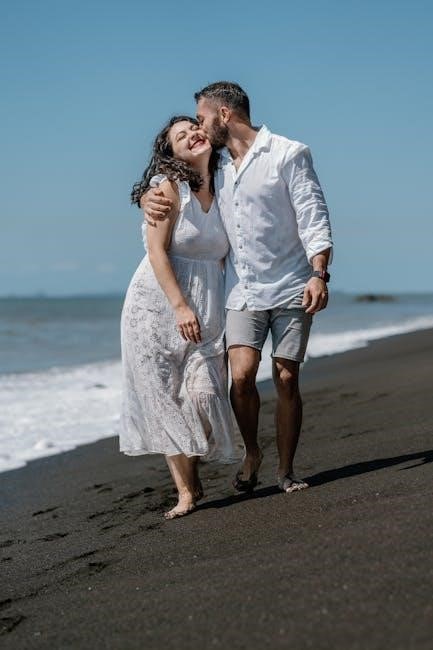A well-fitting dress shirt boosts confidence and style. Accurate sizing begins with neck and sleeve measurements, ensuring a comfortable and polished appearance.
Why Proper Fit Matters
A proper fit is crucial for both style and functionality. A dress shirt that fits well enhances posture, boosts confidence, and ensures comfort throughout the day. An ill-fitting shirt can be restrictive, causing discomfort and distraction. Whether for professional or social settings, a tailored fit creates a polished appearance, making it essential for making a good impression. Proper sizing ensures the shirt moves naturally with the body, avoiding excessive fabric or tight constraints. By prioritizing accurate measurements and understanding personal body type, men can achieve a shirt that feels as good as it looks, elevating their entire wardrobe.
Common Challenges in Sizing
Many men struggle with finding the perfect fit due to varying body types and inconsistent sizing standards across brands. Different manufacturers may have unique measurements, leading to confusion. Additionally, factors like posture and personal preference can affect how a shirt feels. Some may find sleeves too long or too short, while others might experience tightness around the neck or chest. These challenges highlight the importance of accurate self-measurement and understanding how sizing charts vary. By knowing one’s exact measurements and being aware of brand-specific fits, men can overcome these obstacles and select a shirt that offers both comfort and style.

Key Measurements for Dress Shirts
Accurate sizing relies on neck, sleeve length, chest, and waist measurements. These dimensions ensure a tailored fit, balancing comfort and style for various body types and preferences.
Neck Size: The Primary Measurement
Neck size is the foundation of dress shirt sizing, ensuring comfort and a polished look. Measure around the base of your neck, keeping the tape snug but not tight. Sizes typically range from 13 to 19 inches, increasing in half-inch increments. A well-fitting collar should allow one finger between the neck and shirt for a classic fit or no space for a slim fit. Proper neck sizing prevents the collar from being too tight or too loose, crucial for both aesthetic appeal and comfort throughout the day. Accurate measurement is essential for a tailored appearance and optimal wearability.
Sleeve Length: Ensuring the Right Fit
Sleeve length is the second key measurement for dress shirts, ensuring comfort and style. Measure from the center back of your neck, over your shoulder, and down to your cuff. Sizes range from 32 to 37 inches in half-inch increments. Proper sleeve length allows cuffs to sit just above your wrist when arms are slightly bent. Too long, and the shirt looks oversized; too short, and it appears ill-fitting. Balanced sleeve length complements the body type, ensuring the shirt drapes naturally and maintains a polished appearance. Accurate measurement ensures sleeves align with your wrist, creating a tailored finish essential for a professional look.
Chest and Waist Measurements
Chest and waist measurements are crucial for achieving a balanced fit. The chest measurement determines how the shirt fits around your torso, while the waist measurement ensures a tailored silhouette. Measure your chest around the fullest part, keeping the tape level. For the waist, measure at the narrowest point, typically just above the hips. Proper chest and waist proportions prevent the shirt from being too tight or boxy. Ensure the shirt skims your body without restriction, allowing freedom of movement. Accurate chest and waist measurements, combined with neck and sleeve lengths, create a shirt that flatters your physique and enhances your overall appearance.

Understanding Body Types and Fit
Body type significantly impacts dress shirt fit. Slim, average, or broader frames require tailored styles to flatter proportions, ensuring comfort and a polished appearance regardless of build.
How Body Type Affects Shirt Fit
Your body type plays a crucial role in determining the ideal dress shirt fit; Slim individuals benefit from tailored or slim-fit shirts, while broader frames may prefer classic or relaxed styles. Muscular builds should opt for shirts with adequate chest and shoulder room, while taller men often require longer sleeves. Petite individuals should avoid oversized shirts to maintain a balanced look. Understanding your body proportions helps you choose styles that flatter your physique, ensuring both comfort and a polished appearance. Accurate measurements and style selection based on body type are key to achieving the perfect fit.
Fit Recommendations for Different Body Types
Your body type determines the best dress shirt fit. Slim individuals should opt for slim-fit shirts to avoid excess fabric, while muscular builds benefit from shirts with room in the chest and shoulders. Taller men often require shirts with longer sleeves and tails for proportion. Broader frames may prefer classic or relaxed fits to accommodate the chest and waist. Athletic builds can choose between slim or classic fits, depending on muscle definition. Petite men should avoid oversized shirts to maintain balance. Understanding your body type and selecting the right fit ensures a comfortable, flattering appearance tailored to your unique physique.
Dress Shirt Fit Styles
Dress shirts come in slim, classic, and relaxed fits. Slim fits offer a tailored look, classic fits provide comfort, and relaxed fits suit broader body types.
Slim Fit vs. Classic Fit
Slim Fit shirts are tailored closer to the body, offering a modern, streamlined look with narrower sleeves and a shorter length. They suit lean or athletic builds, creating a sharp, polished appearance. Classic Fit shirts, however, provide a looser, more traditional cut, ideal for comfort and versatility. They accommodate broader body types or those preferring a relaxed style. Slim Fit emphasizes style over comfort, while Classic Fit balances both. Choosing between them depends on personal preference, body type, and the occasion. Both styles ensure a professional look, but Slim Fit is more contemporary, and Classic Fit is timeless and universally flattering.
Relaxed Fit: When to Choose It
A Relaxed Fit dress shirt offers a comfortable, loose cut with ample room through the chest, shoulders, and midsection. It’s ideal for men who prioritize comfort over a tailored look or have a broader body type. This style is perfect for casual settings or layering under sweaters. Relaxed Fit shirts are also suitable for those with larger builds, ensuring ease of movement without restriction. While it may not offer the streamlined appearance of Slim Fit, it provides a comfortable and practical option for everyday wear or less formal occasions, making it a versatile choice in a man’s wardrobe.

How to Measure Yourself Accurately
Use a flexible tape measure to take precise neck, sleeve, chest, and waist measurements. Measure over a fitted T-shirt for the best results and accurate sizing.
Using a Flexible Tape Measure
Accurate measurements are essential for the perfect dress shirt fit. Use a flexible tape measure to ensure precision. Start with your neck size: wrap the tape measure around the base of your neck, keeping it flat and not too tight. Next, measure your sleeve length by placing the tape from the center back of your neck, over your shoulder, and down to your wrist. For chest and waist measurements, wrap the tape around the widest part of your chest and narrowest part of your waist, respectively. Measure over a fitted T-shirt for the most accurate results. Avoid pulling the tape too tight or leaving it too loose to ensure proper sizing. Taking your time with these measurements guarantees a tailored fit. A well-measured shirt enhances both comfort and style, making it worth the extra effort to get it right.
Tips for Taking Your Measurements
Ensure accuracy by using a flexible tape measure and standing up straight. Wear a slim-fit T-shirt to measure chest and waist. For neck size, place the tape at the base of your neck, keeping it flat and not too tight. Sleeve length is measured from the center back of your neck, over your shoulder, and down to your wrist. Avoid pulling the tape too tight or leaving it too loose. Measure around the widest part of your chest and the narrowest part of your waist. Take measurements in front of a mirror to ensure proper alignment. This guarantees precise sizing for your dress shirt.

Common Fit Mistakes and How to Avoid Them
Common mistakes include sleeves too long or short, collars too tight or loose, and shirts that are either too snug or too boxy. Use a size chart and professional measurements to ensure the best fit.
Signs of a Poor Fit
A poorly fitting dress shirt often shows signs like a collar that’s too tight or loose, puckering fabric around the buttons, or sleeves that restrict movement. If the shirt pulls open between buttons or feels boxy, it’s likely the wrong size. A collar that doesn’t sit comfortably or gaps excessively indicates a poor fit. Sleeves that are too short or long disrupt the overall look, while a shirt that bunches up around the midsection suggests improper tailoring. Addressing these issues ensures a polished, tailored appearance.
Adjusting for the Perfect Fit
Adjusting your dress shirt involves ensuring the collar sits snugly without gaping, sleeves end just past the wrist, and the shirt skims the torso. If too tight, consider a larger size or relaxed fit. For a looser fit, opt for darts or tailoring. Sleeve length should align with jacket cuffs, and the hem should hit the hip. Proper alterations, like darts or tapering, can enhance fit without losing style; Ensuring the shirt moves naturally with you achieves a polished look tailored to your body.
